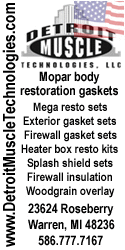- Local time
- 3:50 PM
- Joined
- Apr 13, 2012
- Messages
- 40,874
- Reaction score
- 153,264
- Location
- Granite Bay CA
I did my first engine rebuild in the 90s, long after I started reading car magazines with articles stating that camshafts had to be broken in. I bought a Chevy 350 from some nationwide rebuilder in 1991 but I don’t recall if they advised it. I’ve done it on every engine anyway. I never lost a cam in a Chevy but none of them were as wild as the Mopar engines I’ve done. Mild cams, weak springs and I’d figure the cam could survive longer. Look how long 318s last…. They had .373 lift and usually peaked around 4400 rpms. The 340s looked radical in comparison with almost .450 lift. The 440 Magnum had what… .458 lift? Nowadays we push lifts to crazy numbers. The roller in the 360 I’m building is considered a mild to moderate grind with .544 lift. The roller I just bought for my 440/495 is .580/.578.
But back to flat tappets,
I’m running a Lunati solid that is also close to .600”. That cam has survived because of what….? I’ve been careful about using the right oil and avoiding extended idling. I have the right springs for it. The lifters are those EDMs that shoot oil through the hole in the bottoms. I followed the guidelines and this one survives. My last cam though… the legendary Mopar 528 solid: It was fine for years but suddenly shed several lobes about 10 months to a year after I switched to a modern oil.
Yeah, same oil for years and no problems then I thought I’d try a modern synthetic that unfortunately was a high detergent formula. In retrospect, I should have seen the outcome just by using common sense. The detergent wiped off any zinc the oil had in it so it just wasn’t properly protected. Once the lifters cut through the surface hardening, it was done. If you lose one lobe, you might blame a lifter that was tight in the bore. When ten of the 16 lobes are failing, you blame the oil.
But back to flat tappets,
I’m running a Lunati solid that is also close to .600”. That cam has survived because of what….? I’ve been careful about using the right oil and avoiding extended idling. I have the right springs for it. The lifters are those EDMs that shoot oil through the hole in the bottoms. I followed the guidelines and this one survives. My last cam though… the legendary Mopar 528 solid: It was fine for years but suddenly shed several lobes about 10 months to a year after I switched to a modern oil.
Yeah, same oil for years and no problems then I thought I’d try a modern synthetic that unfortunately was a high detergent formula. In retrospect, I should have seen the outcome just by using common sense. The detergent wiped off any zinc the oil had in it so it just wasn’t properly protected. Once the lifters cut through the surface hardening, it was done. If you lose one lobe, you might blame a lifter that was tight in the bore. When ten of the 16 lobes are failing, you blame the oil.

 They do start it in the pits but not to break in the cam.
They do start it in the pits but not to break in the cam. 



















